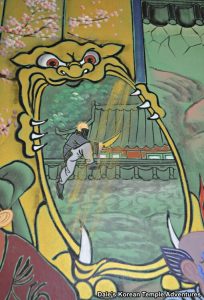“A Step-by-Step Teaching for Understanding Dhyāna-pāramitā” 釋禪波羅蜜次第法門 (T 1916) by Zhiyi is the earliest known text to have the wording of the Four Great Vows as we know them. Unfortunately, this work has not been translated into English.
Category: zen
Jewel Mirror Samadhi Translation Study (寶鏡三昧歌)
From the commentary to Case 6 of the Book of
Serenity: “The Great Master Nagarjuna said, ‘Wisdom is
like a mass of fire – it cannot be entered from any side.
(般若如大火聚。四面不可入。)’
Yet he also said,‘Wisdom is like a clear cool pool, it
an be entered from any side.’
(般若如清涼池。四面皆可入。)’”
念彼觀音力 (nen pi kan-non riki)
念彼觀音力
Sino-Japanese: nen pi kan-non riki (ねん ぴ かん おん りき)
Sino-Korean: yeom pi gwan eum ryeok (염 피 관 음 력)
Watson translation:
Think on the power of that Perceiver of Sounds
Kubo and Yuyuma translation:
If you contemplate the power of Avalokitesvara
木鐸 moktak = wooden bell (not wooden fish)
木鐸
목탁
mok tak
wood bell
“The great ghost of impermanence can come to one at any time.” (無 常大 鬼不期而到。)
無 mu (무); to be without, no, not, nothing
常 sang (상); always, constant, forever, invariable
大 dae (대); great
鬼 gwi (귀); ghost, spirit
不 bul (불); not
期 gi (기); period of time
不期 = unexpected
而 i (이); and
到 do (도); arrive
The Ten Vows of Samantabhadra
一者:禮敬諸佛;二者:稱讚如來;
三者:廣修供養;四者:懺悔業障;
北斗呪 (Mantra of the Northern Dipper)
The seven stars of the Northern Dipper are mighty gods in Heaven.
Rising, they (assemble) in the morning at the Golden Palace (of the Emperor of Heaven),
Setting, they cover the Kunlun Mountains.
They harmonize the principle with (human) law and moral order and control heaven and earth.
“These words seem to be correct and yet are wrong.”
有人云, “自心淨土, 淨土不可生, 自性彌陀, 彌陀不可見!”
此言, 似是而非也.
People say, “Your own mind is the Pure Land, so you cannot be born in the Pure Land; your own nature is Amitābha, so Amitābha cannot be
seen.”
These words seem to be correct and yet are wrong.
The Four Great Vows, Lesson Two
Lesson One:
四 弘 誓 願
眾 生 無 邊 誓 願 度
煩 惱 無 盡 誓 願 斷
法 門 無 量 誓 願 學
佛 道 無 上 誓 願 成
